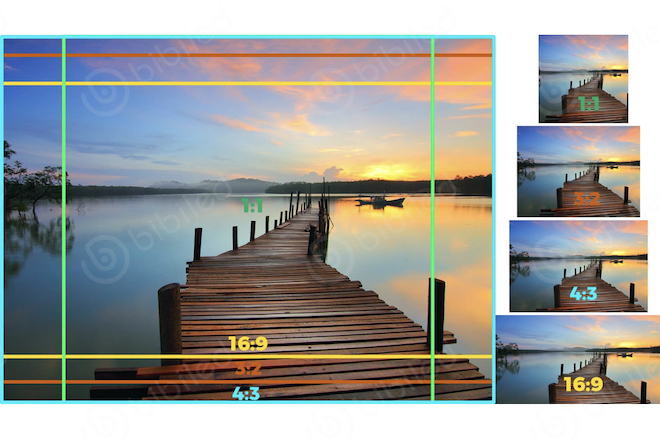1. ما هي نسبة العرض إلى الارتفاع؟
2. كيفية حساب نسبة العرض إلى الارتفاع؟
3. لماذا تعتبر نسب العرض إلى الارتفاع مهمة؟
4. ما هي تنسيقات نسبة العرض إلى الارتفاع الشائعة؟
5. أدوات نسبة العرض إلى الارتفاع
6.16:9 مقابل 4:3، أي نسبة عرض إلى ارتفاع أفضل؟
هل سبق لك أن واجهت مثل هذا الموقف، فيديو عالي الجودة على هاتفك المحمول، ولكن عند تشغيله على الكمبيوتر، تشعر أن الشاشة ممتدة أو لا يمكن ملء الشاشة؟ لماذا هذا؟
السبب هو نسبة العرض إلى الارتفاع، ونسب العرض إلى الارتفاع المختلفة تستوعب أنواعًا مختلفة من الشاشات.
بعد ذلك، دعنا نلقي نظرة على نسبة العرض إلى الارتفاع الأكثر ملاءمة لك عرض الصمام.
1. ما هي نسبة العرض إلى الارتفاع؟
وفقًا لويكيبيديا، فإن نسبة العرض إلى الارتفاع هي النسبة بين عرض الشاشة وارتفاعها، ويتم تمثيلها برقمين مفصولين بعلامة نقطتين (X، Y)، حيث يقابل X العرض ويقابل Y الارتفاع. تشمل نسب العرض إلى الارتفاع الشائعة للشاشات في الماضي والحاضر 5:4 و4:3 و16:10 و16:9.
تشير نسبة العرض إلى الارتفاع إلى العلاقة بين عرض شيء ما وارتفاعه، وغالبًا ما تُستخدم لوصف أجهزة الكمبيوتر وشاشات التلفزيون وأجهزة استشعار الكاميرا والطباعة وشاشات LED الرقمية والمزيد.
باختصار، يتم التعبير عن نسبة العرض إلى الارتفاع لشاشة LED عادةً برقمين مقسومين على نقطتين، حيث يكون العرض عادةً هو الرقم الأول والارتفاع هو الرقم الثاني؛ على سبيل المثال، شاشة 16:9 يبلغ طولها 16 بوصة وارتفاعها 9 بوصات.
2. كيفية حساب نسبة العرض إلى الارتفاع؟
يجب عليك تقسيم الارتفاع الأصلي على العرض الأصلي ثم ضرب هذا الرقم بالعرض الجديد للحصول على الارتفاع الجديد.
ستمنحك هذه الخطوات الارتفاع الصحيح للصورة أو الفيديو الذي قمت بتحريره.
خذ ارتفاعك الأصلي. على سبيل المثال 1200 بيكسل
خذ العرض الأصلي الخاص بك. على سبيل المثال 1600 بكسل
اقسم الارتفاع على العرض، على سبيل المثال 1200/1600=0.75
اضرب الحاصل في العرض المفضل، على سبيل المثال 0.75X300=225
الرقم الناتج هو الارتفاع الجديد الخاص بك معطى بالبكسل.
3. لماذا تعتبر نسب العرض إلى الارتفاع مهمة؟
تلعب نسبة العرض إلى الارتفاع دورًا مهمًا للغاية في شاشتك، وإذا كانت شاشتك تحتوي على نسبة عرض إلى ارتفاع خاطئة، فستتمدد الشاشة أو تقطع أو تضغط أو تنكمش أو تتشوه.
إنها شاشة جديدة عالية الجودة، ولكن بسبب نسبة العرض إلى الارتفاع الخاطئة، فإن تأثير التشغيل لا يلعب تأثير عرض مرئي حقيقي، لذلك من المهم جدًا استخدام نسبة العرض إلى الارتفاع الصحيحة.

4. ما هي تنسيقات نسبة العرض إلى الارتفاع الشائعة؟
فما هي بعض نسب العرض إلى الارتفاع الشائعة؟
- 1:1
الصورة متساوية في الارتفاع والعرض، مثل المربع، وتستخدم عادة في: Instagram، والصور المطبوعة، وشاشات الهواتف، وما إلى ذلك، ولكنها ليست مثالية للمنصات الرقمية الأخرى وأجهزة التلفزيون.
- 5:4
تحظى نسبة العرض إلى الارتفاع هذه بشعبية كبيرة مع كاميرات الأفلام ذات التنسيق المتوسط إلى الكبير، وبالنسبة للتصوير الفوتوغرافي القياسي والصور الفنية، فإن نسبة العرض إلى الارتفاع 5:4 هي نسبة مستخدمة بشكل شائع.
- 3:2
يتم استخدام هذا النوع من نسبة العرض إلى الارتفاع في معظم الكاميرات ذات الإطار الكامل، وهو الأكثر شيوعًا في الكاميرات الرقمية وأجهزة استشعار الهواتف الذكية، والأكثر شهرة في التصوير الفوتوغرافي.
- 4:3
تُستخدم مثل هذه المقاييس غالبًا في الكاميرات المتقدمة ذات أجهزة الاستشعار الصغيرة، على سبيل المثال، تحتوي الكاميرات المدمجة أو كاميرات الهواتف الذكية على أجهزة استشعار صغيرة جدًا.
- 16:9
توفر نسبة 16:9 تنسيق بانورامي وتستخدم هذه النسبة لالتقاط صور أوسع مقارنة بالنسب الأخرى. وهي أكثر شيوعًا في دور السينما وشاشات الكمبيوتر. ونظرًا لنسبتها الكبيرة، يفضل مصورو المناظر الطبيعية هذه النسبة لالتقاط مشاهد أكثر اتساعًا.
5. أدوات نسبة العرض إلى الارتفاع
يعد تحسين نسبة العرض إلى الارتفاع أمرًا مهمًا للغاية، كما تعد الأدوات المستخدمة لضبط نسبة العرض إلى الارتفاع ضرورية لمنشئي المحتوى.
يحتاج المصورون ومصورو الفيديو ومطورو البرامج الذين يقومون بإنشاء محتوى على أجهزة مختلفة إلى تحسين الأجهزة المطابقة الرئيسية: Photoshop، وLightroom، وCapture One، وتطبيقات معالجة الصور على الهواتف المحمولة، وما إلى ذلك.
6.16:9 مقابل 4:3، أي نسبة عرض إلى ارتفاع أفضل؟
16:9 و 4:3 هما اثنتان من نسب العرض إلى الارتفاع الأكثر شيوعًا في الوقت الحالي، ولكن أيهما مناسب لك؟
لا يزال الأمر يعتمد على استخدامك؛ فنسب العرض إلى الارتفاع المختلفة تخدم أنواعًا مختلفة من الصور.
على سبيل المثال:
- احتياجات الفيديو الخاص بك:
عادةً ما يعمل تنسيق 16:9 بشكل أفضل لأن عرض الإطار الناتج يكون أعلى بمقدار 78% من الارتفاعات الأخرى؛ وتكون الصورة الناتجة عريضة الشاشة، ومناسبة لالتقاط مناطق ومقاطع فيديو أوسع مع المزيد من العناصر والتقاط صور أعلى.
- احتياجاتك للتصوير الفوتوغرافي:
4:3 مناسب جدًا لأنه يوفر دقة أعلى وهو مناسب لالتقاط صور للمشاهد الصغيرة.
ما ورد أعلاه لا يمكن استخدامه إلا كمرجع، ويجب تحديد الاحتياجات المحددة وفقًا للموقف الفعلي.
خاتمة:
ما سبق هو المعرفة ذات الصلة بنسبة العرض إلى الارتفاع. بعد فهم المبادئ الأساسية لنسبة العرض إلى الارتفاع، إذا أصبحت صورة العرض غير مستقرة أو ممتدة، فيمكنك أيضًا التفكير فيما إذا كان ذلك هو سبب نسبة العرض إلى الارتفاع لاستكشاف مشكلات العرض وإصلاحها بسرعة.
إذا كان لديك أي أسئلة حول شاشات LED، انقر للمساعدة انت على الفور.
